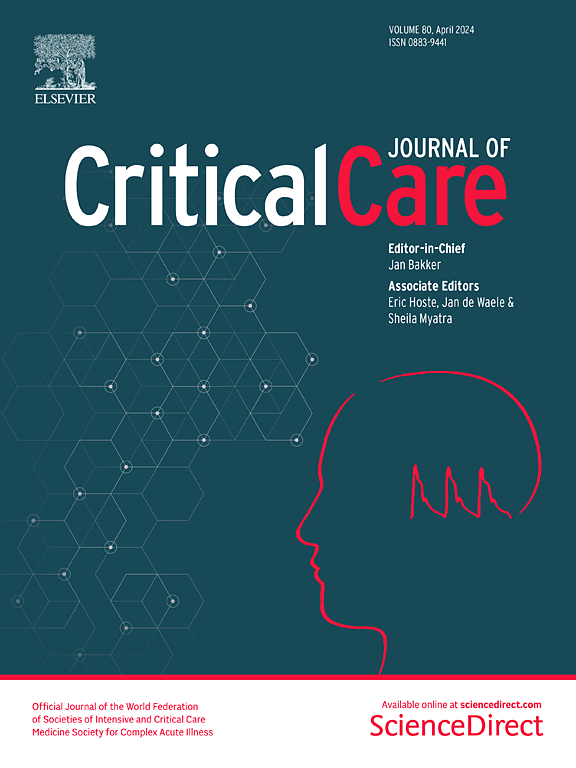在多巴胺和去甲肾上腺素治疗休克的比较中探索不同的统计方法:SOAP II
IF 8.8
1区 医学
Q1 CRITICAL CARE MEDICINE
引用次数: 0
摘要
使用其他方法探索临床试验数据可能会增强原始研究结果并提供新的见解。SOAP II 试验已发表 10 多年,但仍有一些猜测认为,一些患者可能会从多巴胺治疗休克中获益。我们的目的是采用不同的方法重新分析该试验,并评估治疗效果的异质性(HTE)。所有参加 SOAP II 的患者均符合重新分析的条件。我们采用了多种方法,包括胜率(WR)、根据休克类型分层的贝叶斯再分析,以及基于风险和基于效果的 HTE 探讨。这些方法适用于不同的终点,包括死亡、新使用肾脏替代疗法(RRT)和新发心律失常的分层;28 天死亡率;复合终点(死亡率、新使用 RRT 和新发心律失常)以及 28 天内无 ICU 存活天数(DAFICU28)。共纳入 1679 名患者(平均年龄 64.9 岁,57% 为男性,62% 为脓毒性休克,17% 为心源性休克)。所有分析均认为去甲肾上腺素比多巴胺更有效。根据 WR 方法,多巴胺的获胜率低于去甲肾上腺素(WR 0.79;95% 置信区间 [CI] 0.68-0.92;P = 0.003),这在心源性休克和脓毒性休克亚组中都很明显。针对休克类型的贝叶斯再分析显示,多巴胺对死亡率的危害概率为0.95,对复合终点的危害概率大于0.99,对DAFICU28的危害概率为0.91。心源性休克患者使用多巴胺的 DAFICU28 更低(0.92)。根据基于风险的 HTE,多巴胺极有可能导致预测死亡风险最高四分位数的 DAFICU28 减少。基于效应的 HTE 评估模型并不推荐多巴胺优于去甲肾上腺素,包括年龄、休克类型、是否存在心肌病和 SOFA 评分在内的任何可能的调节因素组合。当基于效应的模型推荐使用去甲肾上腺素时,使用多巴胺会导致复合终点绝对值增加 6%。使用多巴胺治疗休克对脓毒症和心源性休克患者似乎都有危害。没有发现任何亚组的多巴胺疗效优于去甲肾上腺素。本文章由计算机程序翻译,如有差异,请以英文原文为准。
Exploration of different statistical approaches in the comparison of dopamine and norepinephrine in the treatment of shock: SOAP II
Exploring clinical trial data using alternative methods may enhance original study’s findings and provide new insights. The SOAP II trial has been published more than 10 years ago; but there is still some speculation that some patients may benefit from dopamine administration for shock management. We aimed to reanalyse the trial under different approaches and evaluate for heterogeneity in treatment effect (HTE). All patients enrolled in SOAP II were eligible for reanalysis. We used a variety of methods including the win-ratio (WR), a Bayesian reanalysis stratified according to shock type, and both a risk-based and effect-based explorations for HTE. The methods were applied to different endpoints, including a hierarchy of death, new use of renal-replacement therapy (RRT), and new-onset arrhythmia; 28-day mortality; a composite endpoint (mortality, new use of RRT, and new-onset arrhythmia), and days alive and free of ICU at 28-days (DAFICU28). A total of 1679 patients were included (average age was 64.9 years, 57% male, 62% with septic and 17% with cardiogenic shock). All analysis favoured norepinephrine over dopamine. Under the WR approach, dopamine had fewer wins compared to norepinephrine (WR 0.79; 95% confidence intervals [CI] 0.68–0.92; p = 0.003), evident in both cardiogenic and septic shock subgroups. The Bayesian reanalysis for type of shock showed, for dopamine, a probability of harm of 0.95 for mortality, > 0.99 probability of harm for composite endpoint, and 0.91 probability of harm for DAFICU28. The fewer DAFICU28 with dopamine was more apparent in those with cardiogenic shock (0.92). Under the risk-based HTE, there was a high probability that dopamine resulted fewer DAFICU28 in the highest quartile of predicted mortality risk. The effect-based HTE assessment model did not recommended dopamine over norepinephrine for any combination of possible modifiers including age, type of shock, presence of cardiomyopathy, and SOFA score. Receiving dopamine when the effect-based model recommended norepinephrine was associated with an absolute increase in composite endpoint of 6%. The harm associated with the use of dopamine for the management of shock appears to be present in both septic and cardiogenic shock patients. There was no suggestion of any subgroup in which dopamine was found to be favourable over norepinephrine.
求助全文
通过发布文献求助,成功后即可免费获取论文全文。
去求助
来源期刊

Critical Care
医学-危重病医学
CiteScore
20.60
自引率
3.30%
发文量
348
审稿时长
1.5 months
期刊介绍:
Critical Care is an esteemed international medical journal that undergoes a rigorous peer-review process to maintain its high quality standards. Its primary objective is to enhance the healthcare services offered to critically ill patients. To achieve this, the journal focuses on gathering, exchanging, disseminating, and endorsing evidence-based information that is highly relevant to intensivists. By doing so, Critical Care seeks to provide a thorough and inclusive examination of the intensive care field.
 求助内容:
求助内容: 应助结果提醒方式:
应助结果提醒方式:


